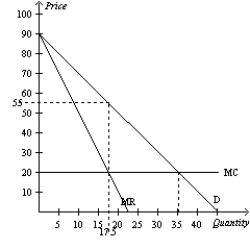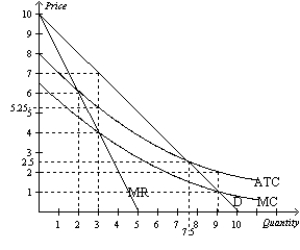A) ABE
B) BCFE
C) EFG
D) ACG
F) B) and D)
Correct Answer

verified
Correct Answer
verified
Multiple Choice
If a monopolist can sell 7 units when the price is $4 and 8 units when the price is $3, then the marginal revenue of selling the eighth unit is equal to
A) $3.
B) $4.
C) $24.
D) -$4.
F) A) and C)
Correct Answer

verified
Correct Answer
verified
Multiple Choice
The reason to regulate utilities instead of using antitrust laws to promote competition is that a utility is usually a
A) profit-maximizing monopoly.
B) producer of externalities.
C) revenue-maximizing monopoly.
D) natural monopoly.
F) B) and D)
Correct Answer

verified
Correct Answer
verified
Multiple Choice
Natural monopolies differ from other forms of monopoly because they are
A) not subject to barriers to entry.
B) not regulated by government.
C) unable to sustain long-run profits.
D) are generally not worried about competition eroding their monopoly position in the market.
F) C) and D)
Correct Answer

verified
Correct Answer
verified
Short Answer
Comparing firms in perfectly competitive markets to monopoly firms, which charges higher prices?
Correct Answer

verified
Correct Answer
verified
True/False
Firms with substantial monopoly power are quite common because many goods are unique.
B) False
Correct Answer

verified
Correct Answer
verified
Short Answer
Figure 15-22  -Refer to Figure 15-22. If the monopolist uses perfect price discrimination, how much output does the firm produce?
-Refer to Figure 15-22. If the monopolist uses perfect price discrimination, how much output does the firm produce?
Correct Answer

verified
Correct Answer
verified
Multiple Choice
Table 15-21
Tommy's Tie Company, a monopolist, has the following cost and revenue information. Assume that Tommy's is
able to engage in perfect price discrimination.
 -Refer to Table 15-21. If the monopolist can engage in perfect price discrimination, what is the marginal revenue from selling the 8th tie?
-Refer to Table 15-21. If the monopolist can engage in perfect price discrimination, what is the marginal revenue from selling the 8th tie?
A) $45
B) $60
C) $80
D) $95
F) A) and B)
Correct Answer

verified
Correct Answer
verified
Short Answer
Figure 15-23  -Refer to Figure 15-23. If the firm profit-maximizes, what amount of output will it produce?
-Refer to Figure 15-23. If the firm profit-maximizes, what amount of output will it produce?
Correct Answer

verified
Correct Answer
verified
True/False
If the government regulates the price a natural monopolist can charge to be equal to the firm's average total cost, the firm has no incentive to reduce costs.
B) False
Correct Answer

verified
Correct Answer
verified
Multiple Choice
Patent and copyright laws encourage
A) creative activity.
B) research and development.
C) competition among firms.
D) Both a and b are correct.
F) A) and B)
Correct Answer

verified
Correct Answer
verified
Multiple Choice
A profit-maximizing monopolist charges a price of $14. The intersection of the marginal revenue curve and the marginal cost curve occurs where output is 15 units and marginal cost is $7. What is the monopolist's profit?
A) $90
B) $105
C) $180
D) Not enough information is given to determine the answer.
F) None of the above
Correct Answer

verified
Correct Answer
verified
Short Answer
Scenario 15-11
Vincent operates a scenic tour business in Boston. He has one bus which can fit 50 people per tour and each tour lasts 2 hours. His total cost of operating one tour is fixed at $450. Vincent's cost is not reduced if he runs a tour with a partially full bus. While his cost is the same for all tours, Vincent charges each passenger his/her willingness to pay: adults $18 per trip, children $10 per trip, and senior citizens $12 per trip. At those rates, on a typical day Vincent's demand is:
 Assume that Vincent's customers are always available for the tour; therefore, he can fill his bus for each tour as long as there is sufficient total demand for the day.
-Refer to Scenario 15-11. What is Vincent's cost of serving all passengers demanding a tour on a typical day?
Assume that Vincent's customers are always available for the tour; therefore, he can fill his bus for each tour as long as there is sufficient total demand for the day.
-Refer to Scenario 15-11. What is Vincent's cost of serving all passengers demanding a tour on a typical day?
Correct Answer

verified
Correct Answer
verified
Multiple Choice
Monopolies are inefficient because they i) eliminate barriers to entry. Ii) price their product at a level where marginal revenue exceeds marginal cost. Iii) restrict output below the socially efficient level of production.
A) i) and ii) only
B) ii) and iii) only
C) iii) only
D) i) , ii) , and iii)
F) A) and B)
Correct Answer

verified
Correct Answer
verified
True/False
The proper level of government intervention is unclear when dealing with a monopoly.
B) False
Correct Answer

verified
Correct Answer
verified
Multiple Choice
When a monopolist increases the amount of output that it produces and sells, the price of its output
A) stays the same.
B) increases.
C) decreases.
D) may increase or decrease depending on the price elasticity of demand.
F) All of the above
Correct Answer

verified
Correct Answer
verified
Multiple Choice
Table 15-8
The following table provides information on the price, quantity, and average total cost for a monopoly.
 -Refer to Table 15-8. How much extra revenue does the monopolist earn when he lowers the price from $18 to $12?
-Refer to Table 15-8. How much extra revenue does the monopolist earn when he lowers the price from $18 to $12?
A) $10
B) $12
C) $30
D) $41
F) All of the above
Correct Answer

verified
Correct Answer
verified
Multiple Choice
Figure 15-8 ![Figure 15-8 -Refer to Figure 15-8. What area represents the total surplus lost due to monopoly pricing? A) the rectangle A-C) *X B) the triangle 1/2[A-C) *Y-X) ] C) the triangle 1/2[A-B) *Y-X) ] D) the rectangle A-C) *X plus the triangle 1/2[A-C) *Y-X) ]](https://d2lvgg3v3hfg70.cloudfront.net/TB4803/11eaaa28_10bb_d3d8_86f9_4774b83b953c_TB4803_00_TB4803_00_TB4803_00_TB4803_00.jpg) -Refer to Figure 15-8. What area represents the total surplus lost due to monopoly pricing?
-Refer to Figure 15-8. What area represents the total surplus lost due to monopoly pricing?
A) the rectangle A-C) *X
B) the triangle 1/2[A-C) *Y-X) ]
C) the triangle 1/2[A-B) *Y-X) ]
D) the rectangle A-C) *X plus the triangle 1/2[A-C) *Y-X) ]
F) None of the above
Correct Answer

verified
Correct Answer
verified
Multiple Choice
If a pharmaceutical company discovers a new drug and successfully patents it, patent law gives the firm
A) partial ownership of the right to sell the drug for a limited number of years.
B) partial ownership of the right to sell the drug for an unlimited number of years.
C) sole ownership of the right to sell the drug for a limited number of years.
D) sole ownership of the right to sell the drug for an unlimited number of years.
F) A) and C)
Correct Answer

verified
Correct Answer
verified
Multiple Choice
The collection of statutes aimed at curbing monopoly power is called
A) the 14th amendment.
B) the Clayton Act.
C) the Sherman Act.
D) antitrust law.
F) C) and D)
Correct Answer

verified
Correct Answer
verified
Showing 441 - 460 of 637
Related Exams